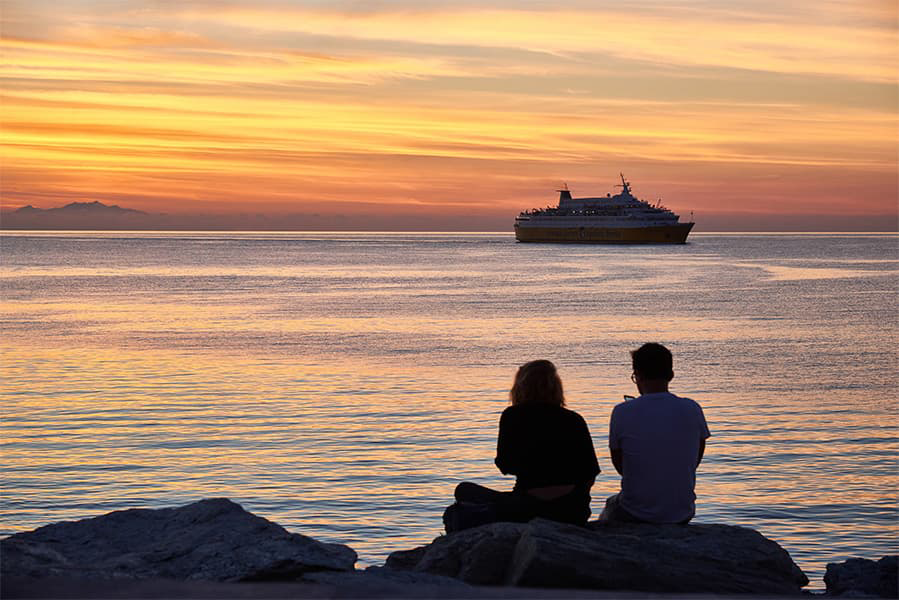Kalymnos - Kastelorizo
Ferries to Dodecanese Islands
Kalymnos - Kastelorizo
Ferries to Dodecanese Islands

The Kalymnos Kastelorizo ferry route connects Dodecanese Islands with Dodecanese Islands. Currently there is just the 1 ferry company operating this ferry service, Blue Star Ferries. The crossing operates up to 2 times each week with sailing durations from around 11 hours 40 minutes.
Kalymnos Kastelorizo sailing durations and frequency may vary from season to season so we’d advise doing a live check to get the most up to date information.
More routes than anyone else.

Compare fares, times & routes in one place.
Change plans easily with flexi tickets.

Book e-tickets & manage trips in-app.
Live ship tracking & real-time updates.

Top-rated customer support when you need it.
Not many nations across the world can boast to have a moniker as unique (or indeed as strange) as the “Sponge-diving Island”, of Kalymnos. The odd nickname is a throwback to the Greek island’s thriving sponge trade when local divers, armed with just a harpoon and a lungful of air, trawled the bottom of the surrounding Aegean Sea in search of so-called “Kalymnian gold”. Such is the importance of sponges to the island’s culture that an annual Sponge Week celebration is held to honour the bravery of divers through the telling of poems, the singing of songs, and even the showing of tribute films. Nowadays Kalymnos is a millionaires’ playground, teeming with wealthy Greeks who want to while away the hours in the glorious warmth of the Mediterranean sun. The island is shaped by a rough and ragged coastline and a landscape of barren hills; their steep slopes marked by solitary pine trees clinging desperately to the rocks. Yet the desolate backcountry is a stark contrast to the beauty of Kalymnos town, where a pristine promenade hugs the deep-blue waters of a bay and narrow streets play host to white-washed buildings topped with terracotta tiles. The entire town is huddled at the foot of a valley; one side coloured by a rare swathe of deep-green where the lemon and tangerine groves of Pothia grow. The port in Kalymnos covers most of the town’s waterfront and consists largely of small piers and jetties lined with yachts that roll with the gentle swell of the waves. The ferry terminal is found on the largest of these piers at the western edge of the bay, just beside a sharp-angled, S-shaped breakwater. It is a small facility consisting of little more than a car-park and a designated section of the roadside where ferries make anchor. Though the port is located in the heart of Kalymnos’ main urban centre, travelling further afield can prove difficult due to the island’s harsh terrain and largely remote nature. The best way to get around is by following the single, main road that circles around the spine of mountains that cut across the region from the south-east to the north-west. This route – regularly traversed by local buses - leads directly from the ferry terminal, slices through Kalymnos town, and snakes away to the smaller villages of Mirties, Arginonta, and Vathis. A wide range of ferry routes currently operate from the port throughout the week, most hopping to the multitude of neighbouring islands. Services hosted by Dodekanisos Seaways sail to Arki, Fournoi, Agios Kirikos, Pyhagorio, Agathonisis, Lipsi, and Chalki as well as sharing the journey to Symi, Rhodes, Tilos, Patmos, Nisyros, Leros, and Kos with Blue Star Ferries. Blue Star Ferries also travel to Astypalea, Kastelorizo and the city of Piraeus on the Greek mainland.
The small Greek island of Kastelorizo, found in a stretch of the Aegean Sea just a mile from the southern coast of Turkey, shot to fame after featuring in Gabriele Salvatores’ 1991 Oscar-winning flick Mediterraneo; a drama set in World War Two about a group of Italian soldiers who find themselves stranded on the island. Today it is a haven for holidaymakers looking for a pleasantly warm and secluded spot in the Mediterranean. From the sky, Kastelorizo looks like a rough-edged triangle pointing south towards the distant shores of Africa. The island is sparsely populated and most of the landscape is dominated by Karst mountains, their slopes mottled dark green by a sparse covering of shrubs and pines. These mountains rise higher as they sweep west and consequently the only settlements on the island surround the cape that cuts into the much flatter eastern coastline. The port in Kastelorizo is found in a town of the same name. It sits on the edge of a long and charming promenade that borders water so crystal-clear that the seabed is visible beneath the surface. A neat row of white-walled villas, their rooves tiled in red terracotta and their windows hidden behind multi-coloured shutters, line the waterside too. This magnificent tableau is what ferry-goers first see as they are taken into the town’s bay and are dropped off at the western side of the promenade. Only a few paved roads cover Kastelorizo and most are cut short by the sharp climbs of the hills in the west. As such, the uninhabited western point of the island cannot be reached by car. There is no system of public transport either, though a shuttle bus runs flits between the town centre of Kastelorizo and the island’s small airport just under 2-miles away. A range of ferry routes currently operate from the port in Kastelorizo a few times throughout the week. Services hosted by Blue Star Ferries sail out of the cape before heading west to a smattering of Dodecanese islands, namely Kos, Nisyros, Kalymnos, Symi, Astypalea.